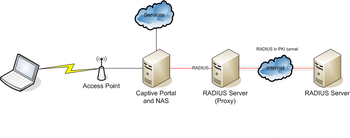Objective 1.7: Wireless
Objective 1.7: Compare the characteristics of wireless communication standards
| 802.11a | 802.11b | 802.11g | 802.11n | 802.11ac | 802.11ad | |
|---|---|---|---|---|---|---|
| Speed | 54 Mbit/s | 11 Mbit/s | 54 Mbit/s | 600 Mbit/s | 6.93 Gbps | 7Gbps |
| Distance | 35 meters | 38 meters | 100 meters | 300 meters | ||
| Channels | 24 | 11 | 11 | 24 | ||
| Frequency | 5 GHz | 2.4 GHz | 2.4 GHz | 2.4/5 GHz | 5 GHz | 60 GHz |
Authentication and encryption
[edit | edit source]Wi-Fi Protected Access (WPA and WPA2) is a class of systems to secure wireless (Wi-Fi) computer networks. It was created in response to several serious weaknesses researchers had found in the previous system, Wired Equivalent Privacy (WEP). WPA implements the majority of the IEEE 802.11i standard, and was intended as an intermediate measure to take the place of WEP while 802.11i was prepared. WPA is designed to work with all wireless network interface cards, but not necessarily with first generation wireless access points. WPA2 implements the full standard, but will not work with some older network cards. Both provide good security, with two significant issues: 1) Either WPA or WPA2 must be enabled and chosen in preference to WEP. WEP is usually presented as the first security choice in most installation instructions. 2) In the "Personal" mode, the most likely choice for homes and small offices, a passphrase is required that, for full security, must be longer than the typical 6 to 8 character passwords users are taught to employ.
Wired Equivalent Privacy or Wireless Encryption Protocol (WEP) is a scheme to secure IEEE 802.11 wireless networks. It is part of the IEEE 802.11 wireless networking standard. Because wireless networks broadcast messages using radio, they are susceptible to eavesdropping. WEP was intended to provide confidentiality comparable to that of a traditional wired network. Several serious weaknesses were identified by cryptanalysts; a WEP connection can be cracked with readily available software in one minute or less. WEP was superseded by Wi-Fi Protected Access (WPA) in 2003, followed by the full IEEE 802.11i standard (also known as WPA2) in 2004. Despite its weaknesses, WEP provides a level of security that may deter casual snooping.

Remote Authentication Dial In User Service (RADIUS) is an AAA (authentication, authorization and accounting) protocol for applications such as network access or IP mobility. It is intended to work in both local and roaming situations. See Objective 6.4: User Authentication for more information.